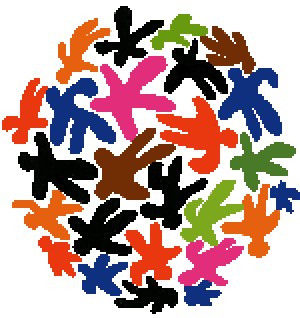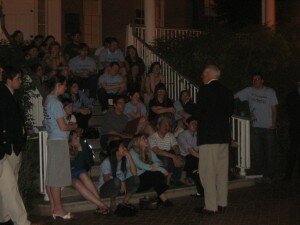Today’s guest post was written by P.J. D’Amico, Senior Associate, Richard Male & Associates. We thought the way he connected traditional organizing principles to online technology – social media for social good – was an interesting construct. We’re curious to know what you think of his ideas – both about traditional organizing and also how they might manifest online.
 Community Organizing Online — The Potential of Social Networking Media
Community Organizing Online — The Potential of Social Networking Media
by P.J. D’Amico
Community organizing has its own unique and demonstrated ways of “meaning making” that must be carefully translated into parallel technological frameworks in order for the technology to be useful in community organizing.
How human beings make meaning together will essentially determine the utility of technology, never the reverse, no matter how awesome the technology.
We must never forget that community organizing occurs principally in our homes and communities not on our laptops.
With this in mind, we must begin to translate the power of community organizing into transferrable principles that can reign in the technology to be a tool that drives people to act with their hands, hearts and minds as well as their Smart Phone.
Below are some of the principle values of community organizing to be rooted in the DNA of emerging technology platforms.
 1. We are all interconnected
1. We are all interconnected
If technology teaches us anything about community, it is that we are all inextricably connected and interdependent within a web of global relationships.
The place we call community can now be as expansive as we choose to imagine.
We can have a direct impact in Africa by what we do everyday in our local communities.
It is now not only possible to recognize this interdependency but to organize and act through personal relationships with people around the world.
Embedded in Technology:
The lynchpin of community organizing technology is to bring people closer together despite geography and limited financial resources.
What we do to organize in community must be rooted in open source principles so that it can be expanded virtually and virally to impact as many stakeholders as are interested.
In essence we want our community organizing platform(s) to grow beyond our control.
To this end the access to the technology must not be overregulated.
 2. People will make a difference if given the invitation and permission
2. People will make a difference if given the invitation and permission
Mainstream culture typically organizes conversations around trivial matters so as not to offend or be offended.
It is rare that critical issues effecting our quality of life will come up in a gathering of mixed company unless made intentional.
Still, the Obama presidential campaign proved to us that “yes we can” make a difference and that people will show up fully engaged with proper guidance and leadership.
Embedded in Technology:
Every house meeting needs to be led and guided with a set of intentional framing questions and processes.
The person(s) facilitating this process must be comfortable in this role and understand clearly the role of a facilitator as different than an opinion leader.
Embedded throughout the website must be an explicit and implicit set of expectations around meaning making for the group.
The very framing of the technology must demonstrate the power of people to organize for themselves.
 3. Transformational Conversation
3. Transformational Conversation
Everything great always starts with a conversation.
As a small community of able people we may not know how to solve world poverty, but we certainly have the resources at our disposal to help a small community of children in a village struggling from malnutrition.
People who show up because of a particular challenge, want also to have a stake in the solution.
They want to contribute specifically with their unique gifts to the resolution and to be valued for their brilliance and contribution.
Instead of broadcasting both a set of challenges and solutions, create spaces for participants to come up with solutions themselves, which in turn will garner their ongoing participation in the process.
*Make certain that at least 25% of the participants in the conversation are impacted directly by the crisis and can inform the solution making process to be contextualized to fit the actual challenge and not the idea of it (i.e. if we are discussing Tanzanian Girls Education, at least 2-3 of the participants ought to be from Tanzania or the girls themselves).
Embedded in Technology:
Create a dynamic forum of opportunities, discussions and actions steps where people can build differentiated strategies and solutions.
Do not only provide people with prefab solutions, but frame the challenge in such a way that the people in the conversation must come up with the solutions on their own with measured guidance.
The technology must create opportunities that are open ended and not driven by didactic outcomes.
 4. Relational Organizing
4. Relational Organizing
People do not organize around issues as much as they act through relationships.
People are less interested in responding to a generic crisis as they are in helping a person they know impacted by the crisis.
Embedded in Technology:
The technology must be grounded in stories (you cannot turn your back on a person whose story you know).
The technology must create a container for an open exchange of ideas, personal narrative and relationship building.
People want to know texture — people, places, spaces, daily occurrences.
 5. Theology of Organizing
5. Theology of Organizing
Community organizing at its core is steeped in the principle that people have power to realize their potential personal and collective destiny.
This principle is of course rooted in faith. Faith, practiced through community organizing suspends certainty in any one idea, person or vision, to the power and serenity of a group to be more than the sum of its parts.
There is always something bigger going on than any one person can define when true community is leading the way. It is bigger than all of us.
Embedded in Technology:
Organize the technology around magic and miracles not obstacles and problems.
Afford participants to act with some level of audacity, freedom and creativity to imagine and fully realize entirely new solutions and opportunities.
Afford each community the means to self define and invent new ways to address an issue.
To this end, the technology must be organized to expand opportunities and not only to contract into clickable boxes.
In this respect, once you set up the conditions for organizing, the technology needs to get out of the way and not be a distraction.
 6. There Are No Models Here
6. There Are No Models Here
The tendency for organizations is to lead people to a fixed set of outcomes and opportunities.
In contrast, community organizing begins with the premise that people are themselves in the best position to find solutions and create opportunities.
To this end, while it is important to frame a question it is not at all necessary to have all of the answers.
Embedded in Technology:
Organize the platform to be flexible and adaptive to input and ideas.
Build a learning platform‟where the very technology itself can be adapted and responsive based on the input of community.
 7. Make time to eat
7. Make time to eat
Everyone likes to eat!
Food is the great equalizer in community.
When we meet without food, it is just that, a meeting.
But when food is central, a meeting quickly evolves into a gathering of friends.
Trust, friendship, vulnerability, being messy and giving ourselves over to the process are all essential dimensions of community organizing.
We must slow down in order to become present within our community.
Food almost always levels the playing field and invites everyone to stay a while and to become familiar on extraordinary new terms.
Embedded in Technology:
Some part of the community organizing and the parallel technology needs to be rooted in people‟s kitchens.
Trading recipes, having cook offs, check lists for potlucks are all essential elements in community organizing cannot be taken for granted.
 8. Nobody gets off the hook
8. Nobody gets off the hook
Not only does everyone have something they can contribute, but must contribute if they choose to remain involved in the community organizing enterprise.
Too often we organize around money instead of recognizing the innate resources, competency networks, intelligence and opportunities people bring if asked.
Embedded in Technology:
Their must be a myriad of pathways and diverse opportunities for involvement anyone of which ought to be required for continued involvement.
Both in real time or through technology, every participant must pledge in her/his unique way exactly how or what they plan to contribute.
 9. Exponentiality
9. Exponentiality
The house meeting is the root organizing platform for community organizing (not the technology).
Each house meeting ought to be arranged to generate at least three additional house meetings.
Hosting a house meeting is perhaps the most powerful contribution anyone person can make to the cause simply because it creates the conditions to proliferate awareness of the opportunity beyond any one definitive group.
Embedded in Technology:
The technology must be organized so that hosting a house party is intuitive, simple and linked clearly to the cause.
Anyone with or without access to a computer should be able to host a house meeting provided they simply have a circle of friends they are prepared to invite.
It is that simple and the technology should be organized accordingly.
 10. A Second Meeting
10. A Second Meeting
The absolute and only priority for your first community organizing meeting is to set up the conditions, expectations and interest to have a second meeting!
No matter what goals or ideas is shared in the first meeting, the meeting must end with a query for a second meeting.
If the interest is not there, than do not host a second meeting, but if in fact there is a mandate, you are off to the races.
Make certain to organize your time in the meeting to have most all of the people in the circle to decide when and where to have the next meeting.
Embedded in Technology:
Schedule the meeting on location without technology being the driver based on the critical mass of people‟s availability in the room.
Organize an online calendar so that people can email their availability for the second meeting.

 By Zach Maurin, Co-founder and Executive Director of
By Zach Maurin, Co-founder and Executive Director of  Field Corps will recruit, train, and support an annual cohort of community organizers to build and lead local networks.
Field Corps will recruit, train, and support an annual cohort of community organizers to build and lead local networks.

